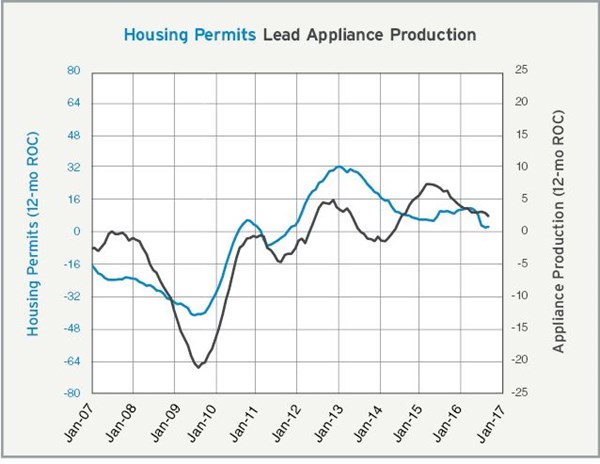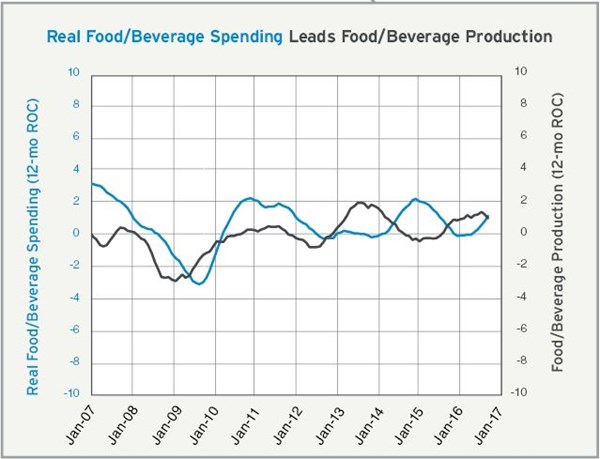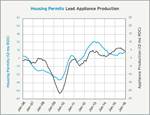Appliances and Packaging
Appliance production should grow faster mid-2017, and strong food/beverage spending should increase packaging demand.
Appliance Production Should Grow Faster Mid-2017
The year-over-year change in the real 10-year treasury rate (the real rate is the nominal rate minus inflation) was virtually unchanged in August and negative for the fourth month in a row, meaning the rate was lower than it was one year earlier. The interest rate is an extremely important indicator for the appliance industry because of its significant impact on the housing market. Generally, a lower rate either encourages refinancing of mortgages, providing cash for home improvements, or it makes the monthly payment of a new mortgage lower, which tends to spur activity in the market. Either tends to lead to purchases of new appliances.
Housing permits also are a reasonably good leading indicator of appliance production because new homes require many new appliances. While the number of housing permits in August was still relatively low when looking back over the last four decades, the current level was almost the highest since 2007. Compared with one year earlier, housing permits increased 10.1 percent, the first growth since March. The annual rate of growth accelerated to 2.3 percent in August, which was the first month of accelerating growth since February. Given the time in which interest rate changes lead changes in housing permits, it very well could be that the rate of growth in housing permits has bottomed and will accelerate for the next six to eight months.
The trend in appliance production for most of the last year was for weaker growth month over month. As a result, the annual rate of change in appliance production (see the black line on the chart) has grown at a decelerating rate since March 2015. It’s possible that the rate of change will stabilize for a few months before it decelerates further. However, based on the leading indicators, accelerating growth in appliance production should return towards the second half of 2017.

Strong Food/Beverage Spending Should Increase Packaging Demand
Even though real disposable income has grown at a decelerating rate for most of the last year, real food and beverage spending has accelerated rapidly. Compared with one year earlier, food and beverage spending each month from May to July grew at least 2.6 percent. This was the fastest three months of growth since June to August 2014. This has caused the annual rate of change to grow at an accelerating rate for four consecutive months. That trend will continue for at the least the next three months.
In August, food and beverage production contracted compared with one year earlier for the first time since March and just the second time since February 2015. Slow growth in recent months has caused the annual rate of growth to decelerate the last two months. However, the rate of growth was still relatively strong compared with the last decade. And given the accelerating growth in food and beverage spending, production should grow faster soon. This would be a positive sign for future packaging demand.

Related Content
-
Dynamic Tool Corporation – Creating the Team to Move Moldmaking Into the Future
For 40+ years, Dynamic Tool Corp. has offered precision tooling, emphasizing education, mentoring and innovation. The company is committed to excellence, integrity, safety and customer service, as well as inspiring growth and quality in manufacturing.
-
OEE Monitoring System Addresses Root Cause of Machine Downtime
Unique sensor and patent-pending algorithm of the Amper machine analytics system measures current draw to quickly and inexpensively inform manufacturers which machines are down and why.
-
Tackling a Mold Designer Shortage
Survey findings reveal a shortage of skilled mold designers and engineers in the moldmaking community, calling for intervention through educational programs and exploration of training alternatives while seeking input from those who have addressed the issue successfully.
.jpg;maxWidth=970;quality=90)
.JPG;width=70;height=70;mode=crop)














.jpg;maxWidth=970;quality=90)